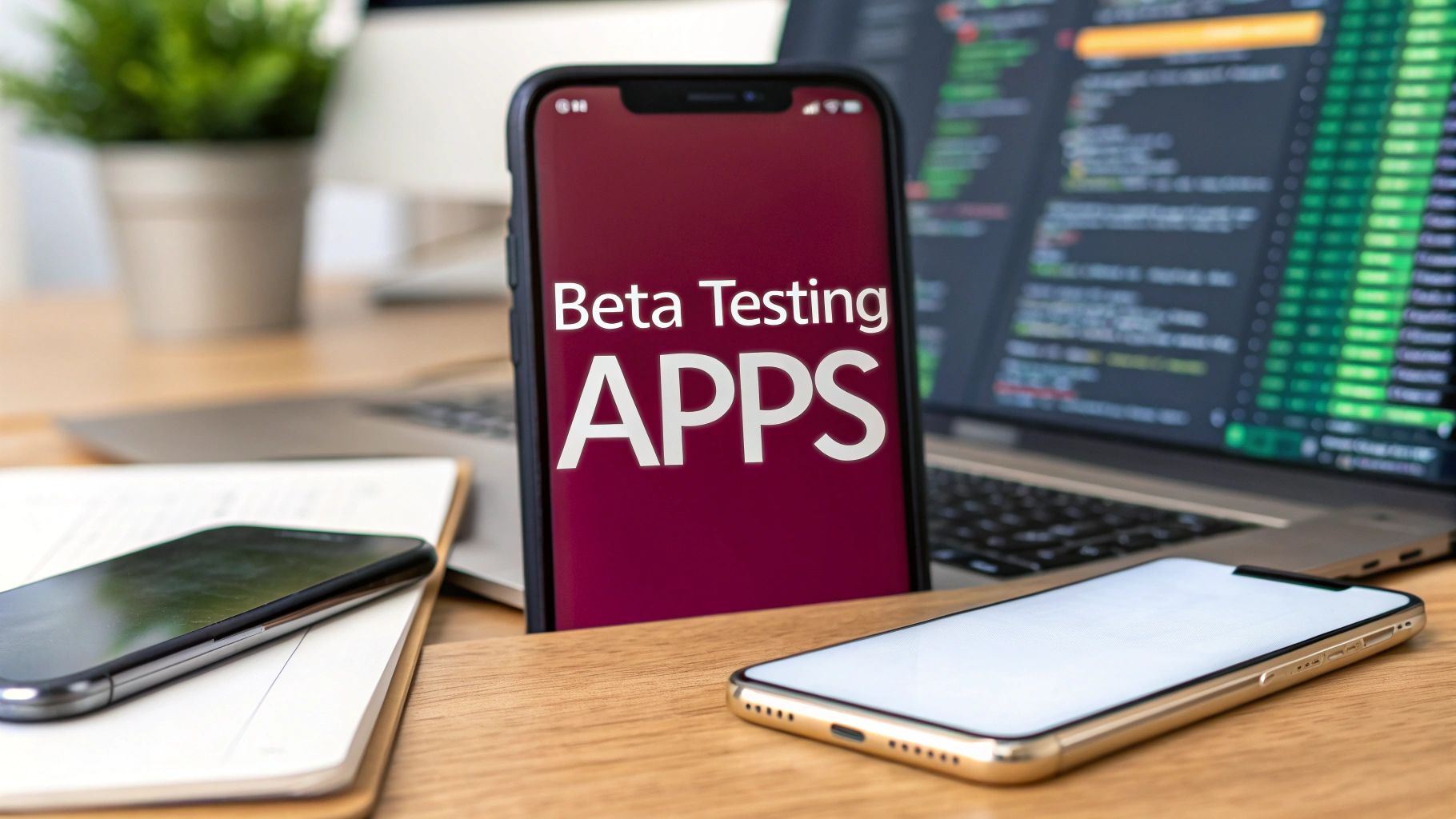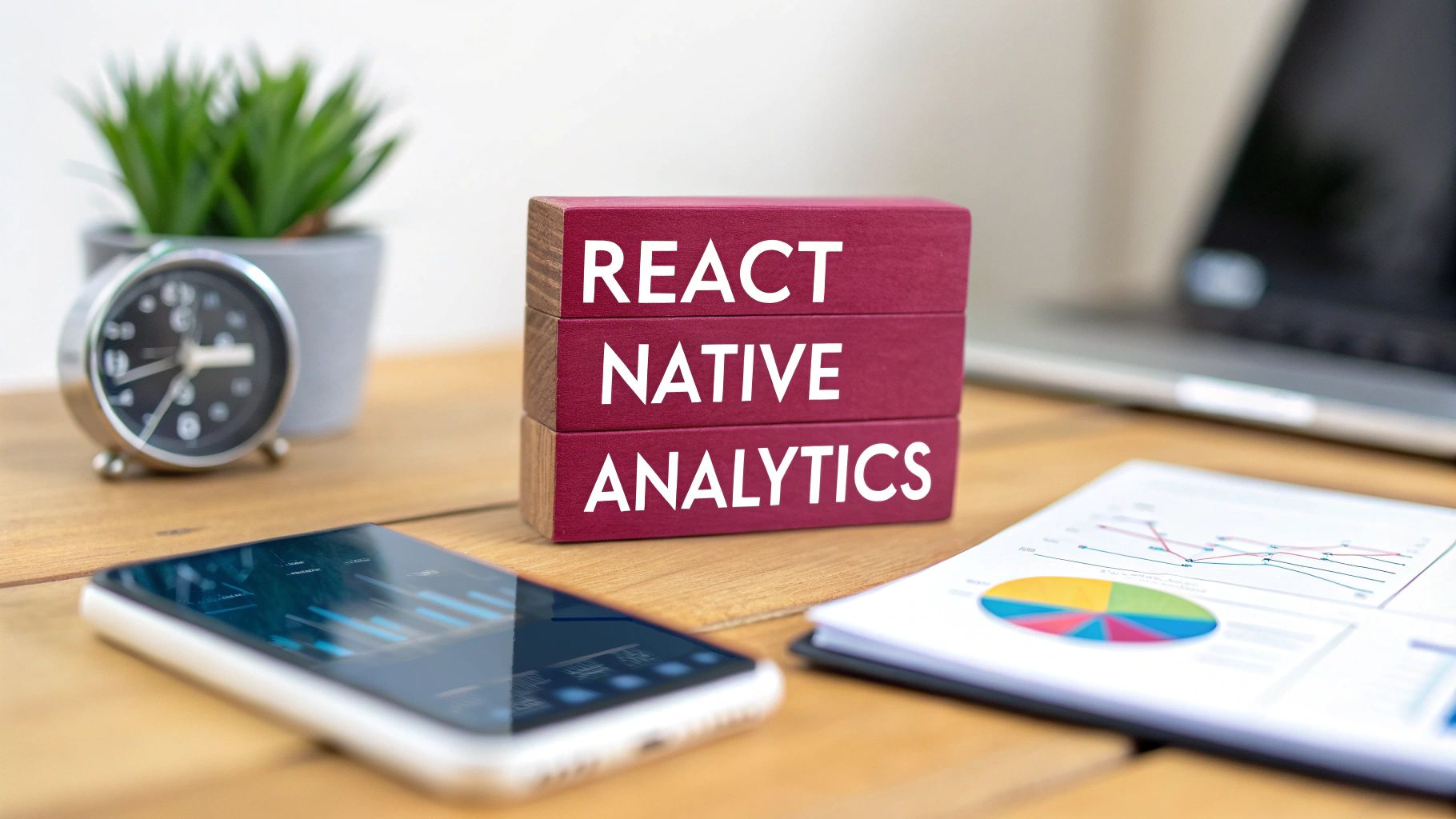In the competitive landscape of mobile applications, a robust beta testing strategy is no longer a “nice-to-have” - it’s a critical component of a successful release cycle. For React Native development teams, the challenge is twofold: managing cross-platform builds and gathering actionable feedback efficiently. A haphazard approach, relying on manual APK/IPA distribution and scattered feedback channels like email or Slack, inevitably leads to missed bugs, delayed timelines, and a compromised user experience upon launch. This process is not only inefficient but also fails to provide the structured, insightful data needed to make informed product decisions.
This resource list is designed to solve that exact problem. We’ve compiled and analyzed the top platforms for beta testing apps, moving beyond generic feature lists to provide a comprehensive guide tailored to the specific needs of React Native developers, product managers, and QA teams. You won’t find marketing fluff here. Instead, you’ll get a detailed breakdown of each tool’s real-world application, integration workflows, and practical limitations.
We will explore a curated selection of platforms, from streamlined over-the-air (OTA) update services like CodePushGo to full-service user feedback platforms such as UserTesting and Testbirds. Each entry provides a direct assessment of its core strengths, identifies ideal use cases, and includes crucial details on pricing and implementation. Our goal is to equip you with the information necessary to select the right tool, streamline your feedback loop, and ultimately ship a more polished, stable, and user-validated React Native application. This guide will help you find the best solution for your team’s specific requirements, complete with direct links and screenshots for every platform.
1. CodePushGo
CodePushGo is a premier platform specifically engineered for React Native teams that need to streamline their beta testing and update deployment processes. It excels at delivering over-the-air (OTA) updates, allowing developers to push bug fixes, feature tweaks, and critical patches directly to users’ devices, bypassing the often lengthy app store review cycle. This capability makes it an invaluable tool for agile development, enabling rapid iteration based on tester feedback.
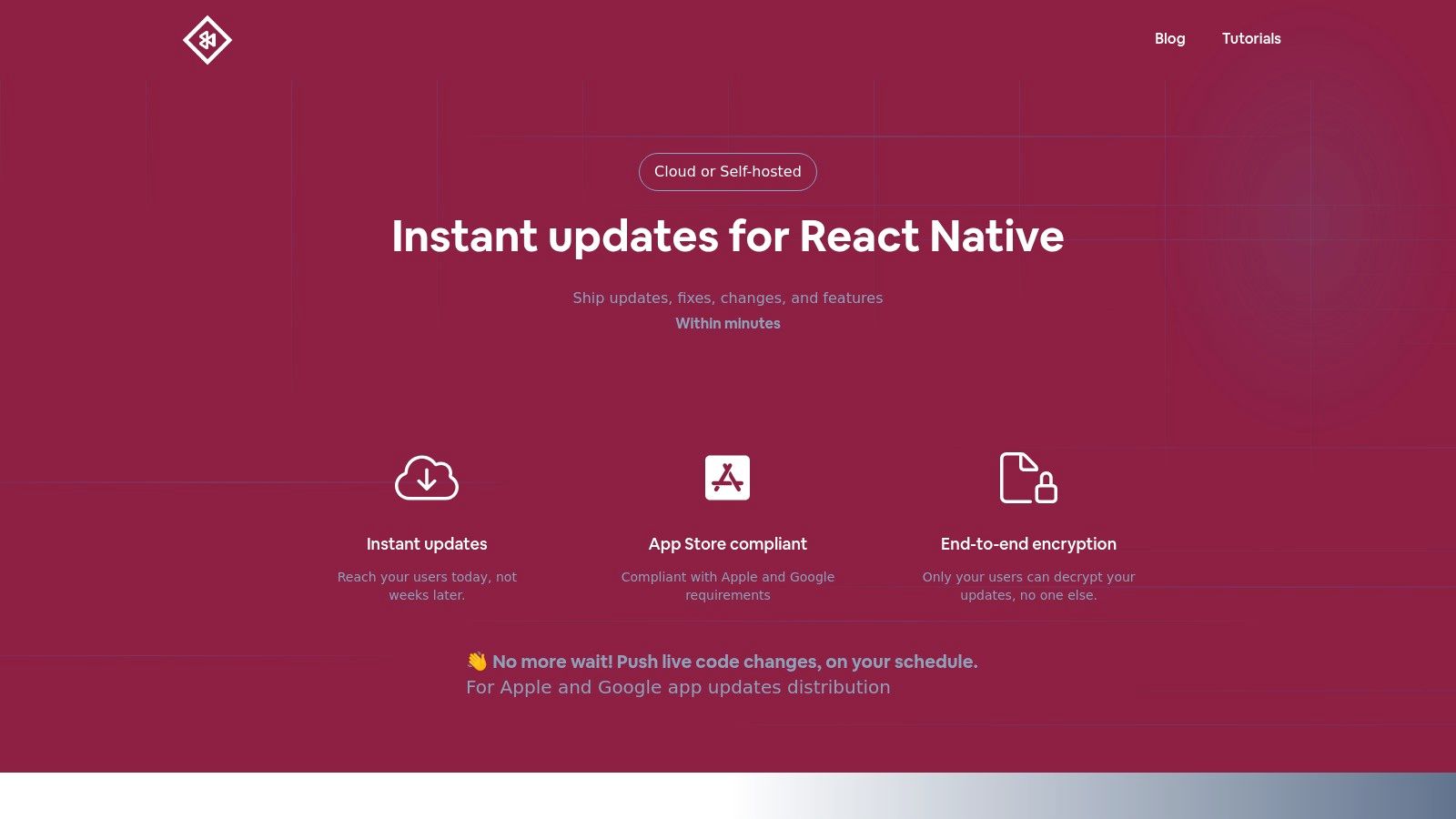
The platform distinguishes itself with a security-first approach, featuring true end-to-end encryption for all code updates. Unlike standard signature-based verification, this ensures that only the end user’s device can decrypt the update payload, providing an unparalleled level of confidentiality for your intellectual property. For teams managing beta testing apps, this means proprietary features remain secure even when distributed to external testers.
Key Features and Use Cases
CodePushGo is built to integrate smoothly into existing workflows and provides granular control over the release process.
- Channel-Based Staged Rollouts: Create specific channels for different user groups, such as
alpha,beta, andproduction. This allows you to deploy new updates to your internal QA team first, then expand to a closed beta group, and finally release to all users, all with simple commands. This controlled exposure is fundamental to effective beta testing. - Smart Differential Updates: To ensure a seamless user experience, the platform only sends the code that has changed. This minimizes download sizes and conserves user bandwidth, making updates fast and unobtrusive, which is crucial for retaining beta testers.
- Real-Time Analytics & Rollbacks: The dashboard provides immediate insight into update adoption rates, installation success, and potential failures. If a beta release introduces a critical issue, you can execute a one-click rollback to instantly revert all users on that channel to the last stable version, minimizing disruption.
CodePushGo transforms the update cycle from a high-stakes, delayed process into a low-risk, continuous delivery pipeline. Its focus on security and granular control makes it a standout choice for professional React Native development and robust beta testing.
Practical Considerations
The platform is designed for professional teams and its pricing reflects that. It involves a one-time setup fee of $2,600 and ongoing CI/CD costs around $300/month. While this may be a significant investment for solo developers or hobbyists, the ROI for established teams is clear, found in accelerated release timelines and enhanced app stability. The platform’s exclusive focus on React Native means it is a specialized tool, not a one-size-fits-all solution for multi-framework environments.
For teams looking to optimize their testing strategy, the platform’s blog offers valuable insights. You can learn more about beta testing best practices on codepushgo.com.
- Website: https://codepushgo.com
- Best For: React Native teams needing secure, rapid OTA updates and controlled beta testing environments.
- Key Strength: True end-to-end encryption and flexible, channel-based rollouts.
2. UserTesting
UserTesting distinguishes itself by focusing on the qualitative, human side of user feedback rather than just crash reporting. It connects React Native development teams with a global panel of real users who provide video and audio feedback while interacting with your app. This platform is less about technical bug hunting and more about understanding the why behind user behavior, making it invaluable for validating UI/UX design choices before a wide release.
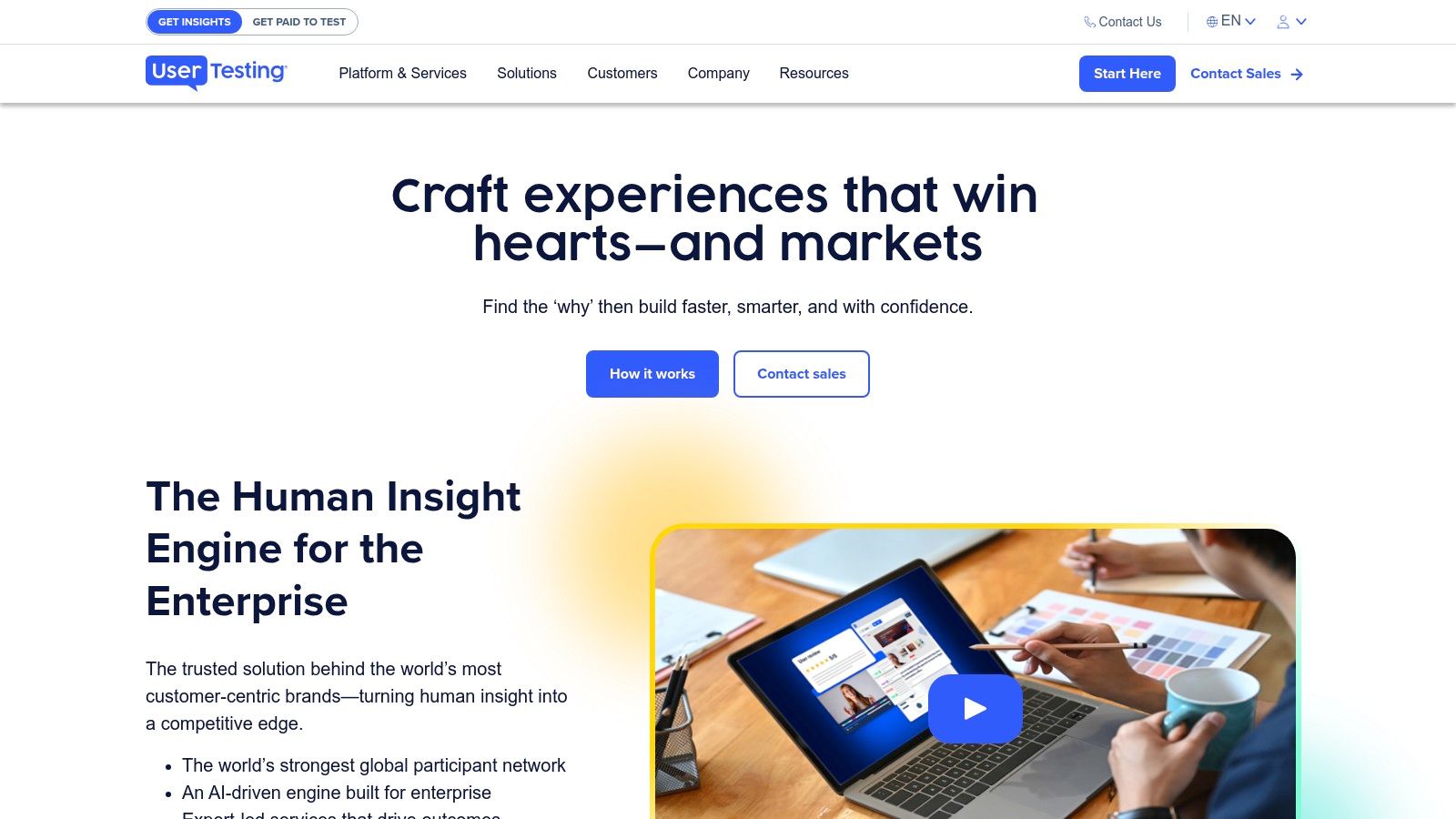
The core offering involves “think-aloud” video recordings. Testers narrate their thoughts, frustrations, and moments of delight as they navigate through specific tasks you’ve defined in your mobile app. This provides raw, unfiltered insight into your app’s usability and intuitive design that quantitative analytics alone cannot capture. For React Native teams, this is crucial for identifying confusing navigation patterns or UI elements that don’t behave as expected on specific devices.
Key Features and Use Cases
- Live Conversations: Engage in real-time, one-on-one interviews with users as they interact with your application, allowing for immediate follow-up questions.
- Targeted Demographics: Filter the UserTesting panel by dozens of attributes like age, income, location, and technical proficiency to match your target user persona.
- Prototype Testing: Get feedback on Figma, InVision, or Adobe XD prototypes before writing a single line of code, saving significant development resources.
Practical Tip: When setting up a test, create very specific tasks and scenarios. Instead of “Test the checkout process,” use “Purchase a blue t-shirt in a size medium using a gift card.” This focused approach yields more actionable and specific feedback on your beta testing apps.
UserTesting’s platform is ideal for product managers and UX designers seeking to validate design hypotheses and improve the overall user journey within their React Native application. While pricing is subscription-based and geared toward enterprise clients, the depth of qualitative insight it provides can be instrumental in building a user-centric product.
Website: https://www.usertesting.com/
3. Testbirds
Testbirds provides a comprehensive, crowdtesting platform that combines the power of a global community with a versatile suite of testing services. For React Native teams, it offers a powerful way to test functionality, usability, and localization across a massive matrix of real-world devices and user demographics. Rather than relying solely on emulators or a limited in-house device lab, Testbirds connects you with testers from around the world, ensuring your app performs as expected for its intended audience, regardless of their location or device.
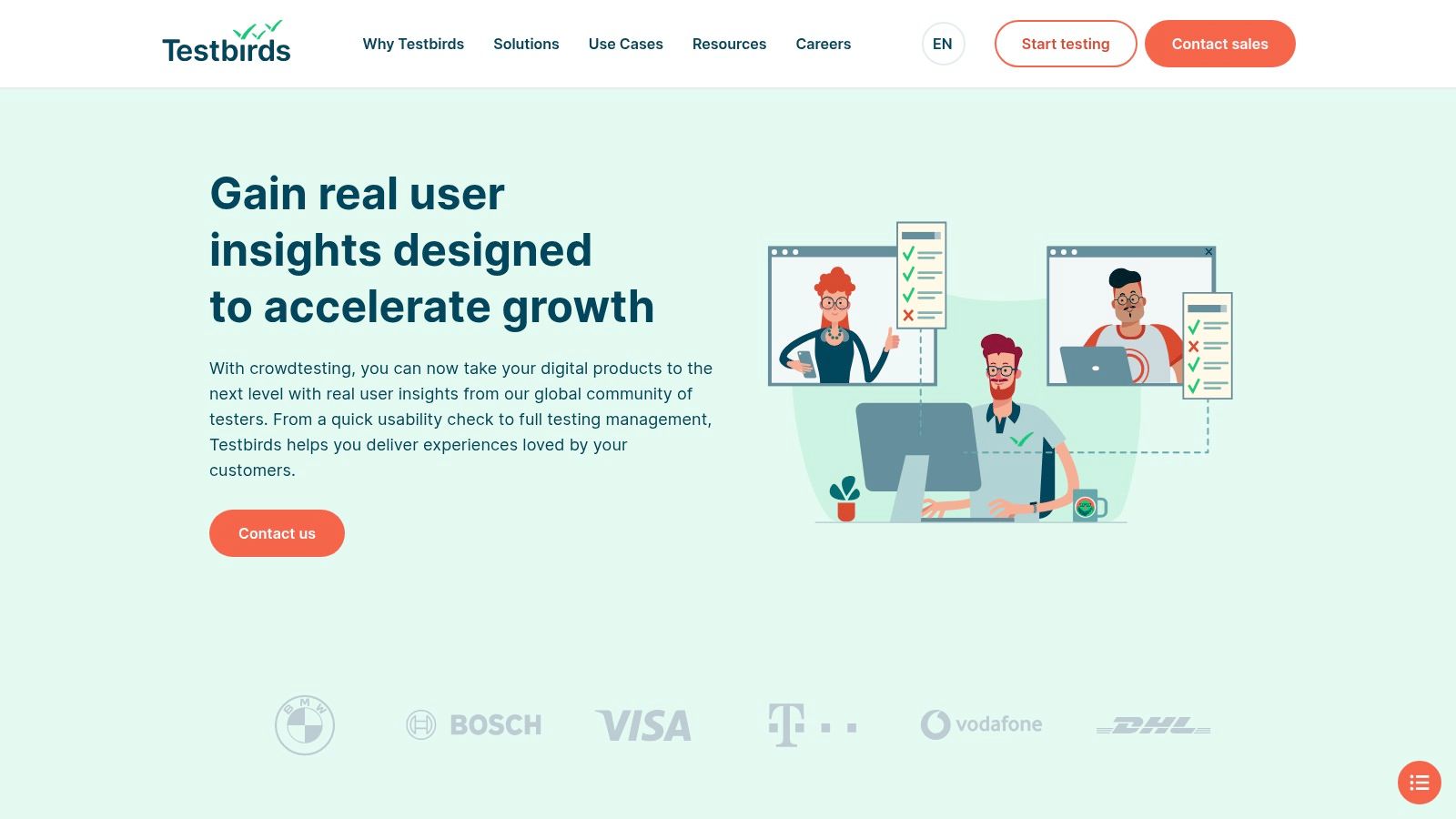
The platform’s strength lies in its hybrid approach. You can launch fully managed test cycles where Testbirds’ experts handle everything from test design to results analysis, or you can use their self-service tools for more direct control. This flexibility makes it a great option for both teams with dedicated QA personnel and those needing to outsource the entire process. The global tester community is particularly beneficial for validating localization and identifying culture-specific usability issues that are often missed in traditional testing.
Key Features and Use Cases
- Crowdtesting: Access a diverse pool of over 1,000,000 testers across 193 countries, covering a vast range of devices, operating systems, and user profiles.
- Localization Testing: Ensure your app’s translations, date formats, and cultural references are appropriate for different international markets by using native speakers.
- Exploratory Bug Tests: Let skilled testers freely explore your React Native app to uncover critical, unexpected bugs and usability flaws that structured test cases might miss.
Practical Tip: When using Testbirds for localization, provide testers with context about your brand voice and the intended meaning behind certain phrases. This helps them provide more nuanced feedback beyond simple literal translations, ensuring your app feels natural and authentic to local users.
Testbirds is ideal for companies scaling their apps internationally or those needing to validate performance on a wide variety of real devices. Its pricing is project-based, allowing you to tailor the scope and cost to your specific needs, making it a scalable solution for finding and fixing bugs before they impact your user base. This makes it one of the more adaptable beta testing apps available.
Website: https://www.testbirds.com/
4. BetaTesting
BetaTesting offers a more streamlined, community-driven approach to beta testing, acting as a marketplace that connects development teams with a diverse pool of real-world testers. Unlike platforms focused solely on technical diagnostics, BetaTesting provides a managed service to find, vet, and engage testers for your React Native app based on specific demographic and technical requirements. This makes it an excellent middle-ground for teams that need structured, qualitative feedback without the enterprise-level cost of platforms like UserTesting.
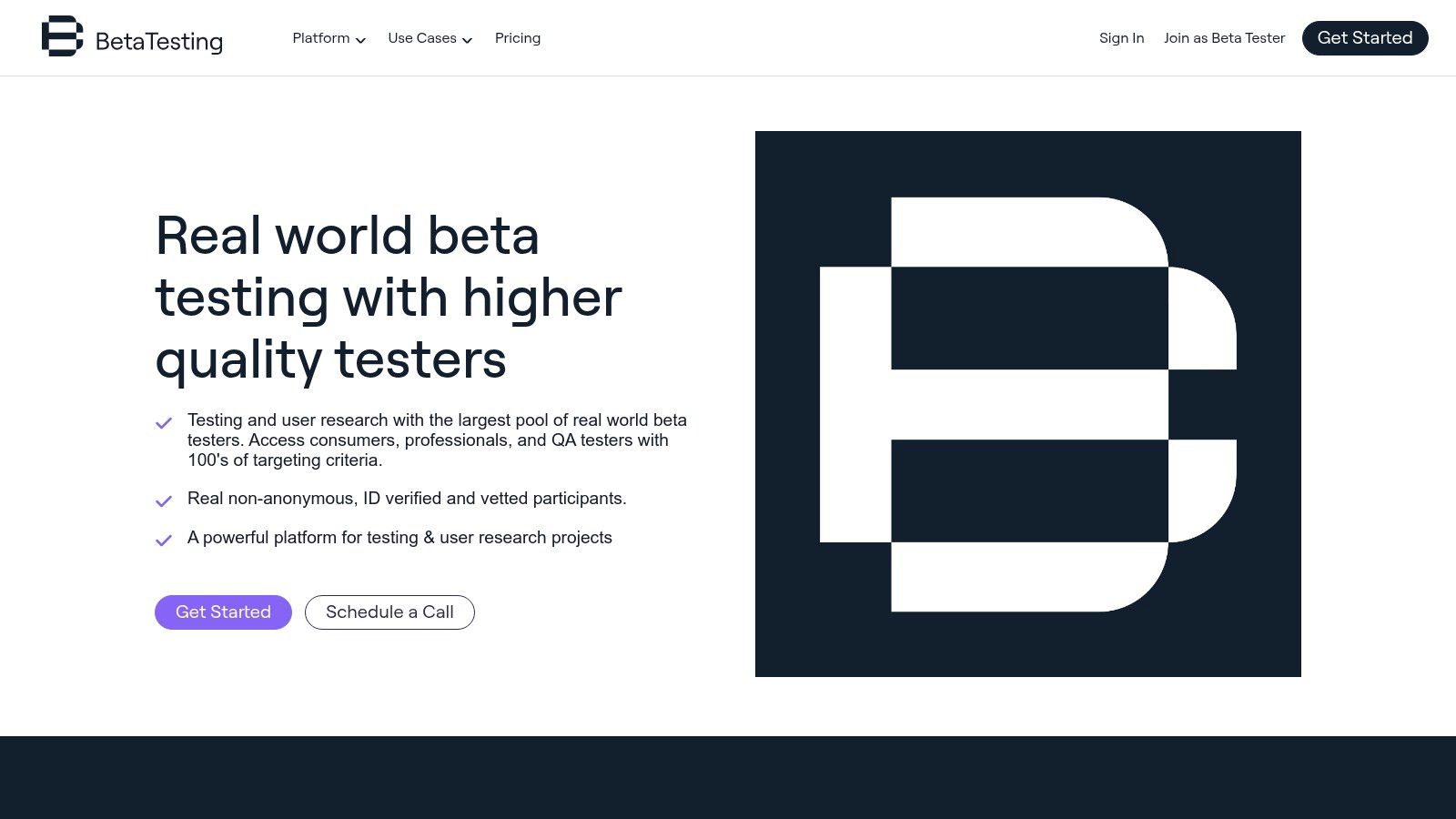
The platform is particularly effective for gathering feedback on usability, first impressions, and feature validation from your precise target audience. You can launch projects targeting users with specific devices (e.g., certain Android versions or iPhone models), interests, or professional backgrounds. Testers complete tasks you define and submit feedback through surveys and bug reports, providing a blend of quantitative and qualitative data that is essential for refining beta testing apps before a public launch.
Key Features and Use Cases
- Managed Tester Recruitment: BetaTesting handles the entire recruitment and payment process, sourcing testers from their community of over 300,000 users.
- Demographic Targeting: Filter testers by age, country, gender, household income, education, and device ownership to accurately match your user personas.
- Flexible Feedback Collection: Collect feedback through bug reports, surveys, and task completion reports, allowing you to structure your test for specific goals.
Practical Tip: For a React Native app, use BetaTesting to run a short “First Impression Test.” Ask testers to use the app for 15 minutes and then complete a survey about the onboarding process, overall design, and initial usability. This can quickly reveal critical flaws in the user journey.
BetaTesting’s project-based pricing makes it accessible for startups and mid-sized companies that need targeted user feedback without committing to a long-term subscription. It’s an ideal solution for product managers and QA leads looking to validate their app with a specific user segment and gather actionable feedback efficiently.
Website: https://betatesting.com/
5. uTest
uTest operates on a crowdsourced testing model, providing development teams access to a massive global community of professional and freelance testers. Unlike platforms that rely on a curated panel, uTest leverages a diverse, real-world user base to perform a wide variety of testing services, from functional and usability testing to localization and security assessments. This makes it a powerful resource for React Native teams looking to validate their app’s performance across an extensive range of devices, operating systems, and network conditions.
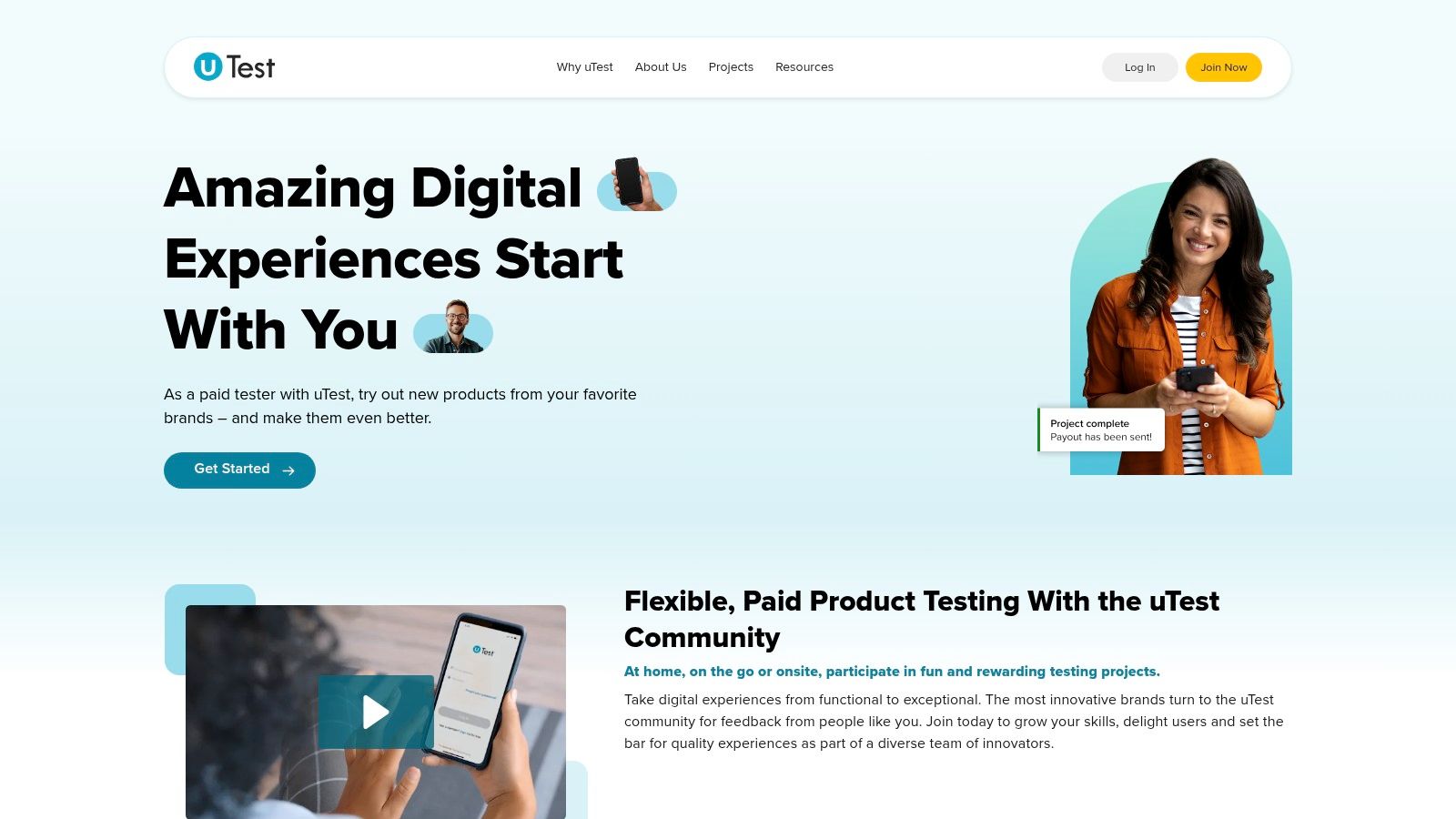
The platform’s strength lies in its scale and flexibility. You can launch “test cycles” targeting specific demographics or technical requirements, allowing testers to compete to find and report bugs. This competitive approach often uncovers edge-case defects that automated scripts or smaller testing groups might miss, making it one of the more comprehensive beta testing apps for thorough bug hunts before a major release. The community-driven model also provides a continuous stream of feedback and bug reports.
Key Features and Use Cases
- On-Demand Global Testers: Access thousands of testers from over 200 countries, enabling true localization and real-world condition testing for your app.
- Types of Testing: Go beyond simple bug reporting with specialized testing, including usability, load, security, and payment testing services.
- Real Device Coverage: Ensure your React Native app functions flawlessly on a vast matrix of real smartphones and tablets, not just emulators.
Practical Tip: To maximize value from uTest, provide extremely clear bug reporting guidelines and a well-defined scope. Since you’ll be working with a diverse crowd, setting clear expectations for what constitutes a valid bug will help you manage the influx of feedback and focus on the most critical issues.
For teams needing to stress-test an application at scale, uTest offers an unmatched level of device and demographic diversity. While managing a large volume of feedback requires a structured approach, it is an excellent solution for identifying critical, real-world bugs that could impact your launch. An effective strategy often involves using a detailed app testing checklist to guide the process.
Website: https://www.utest.com/
6. Beta Family
Beta Family operates as a crowdtesting platform where developers gain access to a global community of real-world testers for their iOS and Android applications. It stands out by giving testers the agency to browse and apply for tests that align with their interests and device specifications. This model fosters a more engaged and motivated tester base, as individuals are actively choosing to participate rather than being passively assigned, making it a useful resource for gathering diverse feedback on beta testing apps.
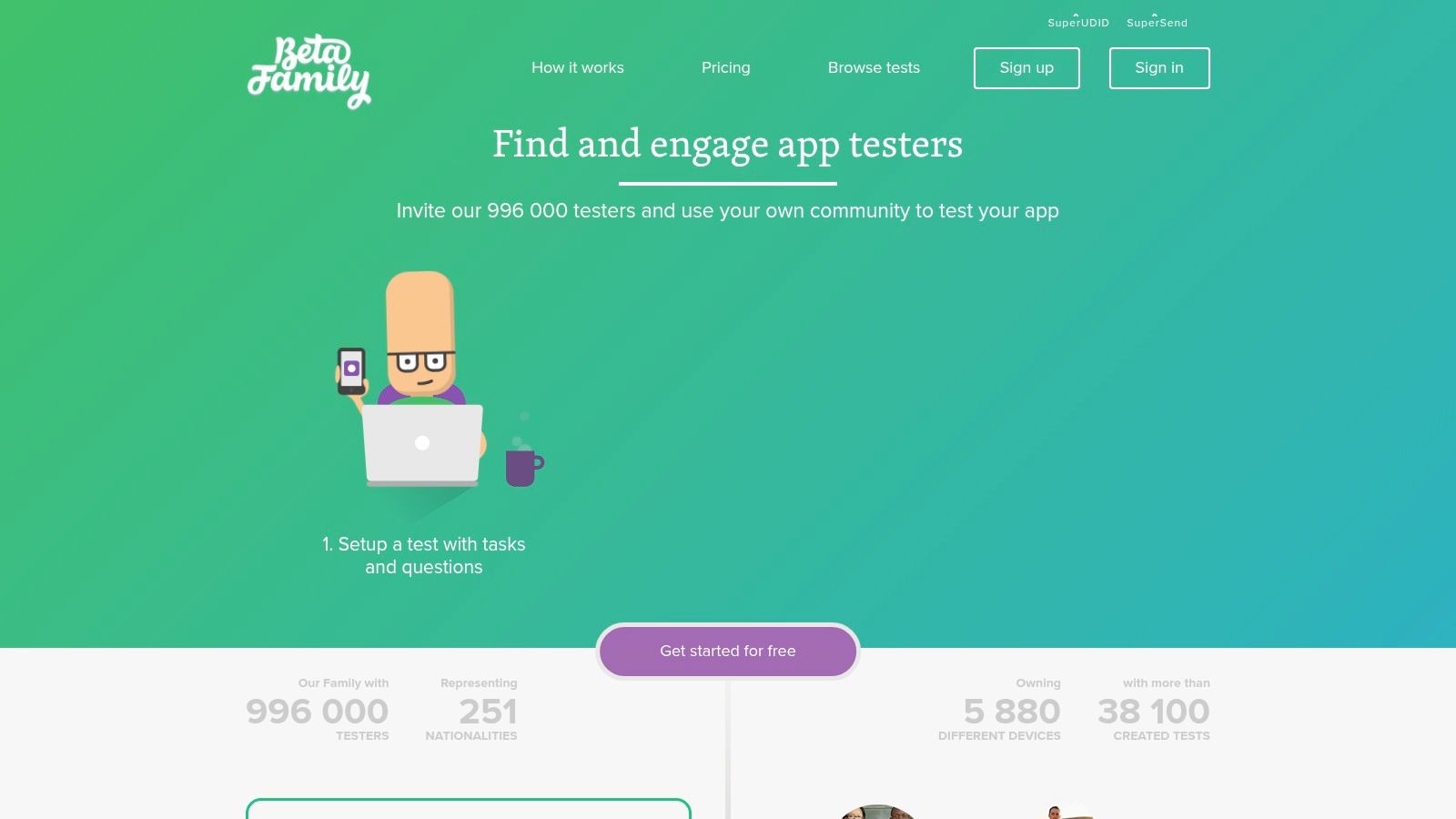
For React Native developers, Beta Family offers a straightforward way to get their app into the hands of a large, varied audience without the overhead of managing a private tester group. The platform facilitates feedback collection, bug reports, and demographic-specific insights. Testers are typically compensated for their time, which incentivizes thorough and high-quality feedback that can be crucial for improving the final product and refining app retention strategies.
Key Features and Use Cases
- Crowdtesting Community: Access a large, diverse pool of testers from around the world to test your app on numerous device and OS combinations.
- Tester-Driven Selection: Testers choose which apps they want to test, often leading to more enthusiastic and relevant feedback from users genuinely interested in your app’s category.
- Incentivized Testing: Testers receive compensation (typically $5-$20 per test), which encourages detailed bug reporting and thoughtful feedback.
- Demographic Filtering: Target specific user segments by filtering testers based on age, gender, country, and the devices they own.
Practical Tip: When posting a test on Beta Family, be very clear about the type of feedback you need. Specify whether you are looking for bug reports, usability feedback, or opinions on a new feature to guide testers and receive the most relevant insights for your React Native project.
Beta Family is particularly well-suited for indie developers and smaller teams who need cost-effective access to a broad testing audience. While the quality of feedback can vary, the platform’s structure provides a valuable opportunity to identify major bugs and usability issues across a wide spectrum of real-world conditions before a public launch.
Website: https://www.betafamily.com/
7. Betabound
Betabound operates differently from direct SDK platforms by functioning as a community-driven hub that connects developers with an enthusiastic pool of real-world testers. It’s not a tool you integrate into your React Native build, but rather a service where you can post your app to find volunteers eager to provide feedback. This makes it an excellent, low-cost option for gathering qualitative insights, uncovering device-specific bugs, and understanding first impressions from a diverse user base.
The platform centralizes the recruitment process, allowing developers to list their “betatest” opportunities and specify their needs. Testers sign up and apply for projects that interest them, ranging from mobile apps and websites to hardware and games. For React Native teams, this provides access to a wide array of devices and user profiles without the overhead of managing a proprietary tester panel, making it one of the more accessible beta testing apps platforms for indie developers or small teams.
Key Features and Use Cases
- Community Recruitment: Tap into a pre-existing community of thousands of engaged beta testers from various technical backgrounds and locations.
- Diverse Testing Opportunities: Post opportunities for not just mobile apps, but also software, hardware, and web applications, ideal for products with a multi-platform presence.
- Incentive-Based Testing: Developers can offer incentives like gift cards, free subscriptions, or other rewards to attract and motivate high-quality testers.
Practical Tip: When creating your project listing on Betabound, be extremely clear about your ideal tester profile, the required devices (e.g., “iPhone 13 running iOS 16+,” “Samsung Galaxy S22 running Android 13+”), and the specific feedback you are seeking. A well-defined listing attracts more relevant and helpful applicants.
Betabound is best suited for the early-to-mid stages of beta testing when you need to gather a broad spectrum of user feedback without a significant financial investment in a managed platform. While you are responsible for managing the feedback collection and communication, the platform provides the essential connection to users you wouldn’t otherwise reach.
Website: https://www.betabound.com/
8. Test IO
Test IO leverages the power of crowdtesting, giving React Native developers access to a global community of professional testers on real devices. This platform excels at finding real-world bugs that automated tests or small internal teams might miss. Instead of just simulated environments, your app is put through its paces by diverse users on a wide array of hardware, network conditions, and operating system versions, making it a powerful resource for functional and usability testing.
The platform operates on a “pay-for-bugs” model, which incentivizes testers to uncover high-impact issues. This approach is particularly effective for identifying edge-case functional bugs and compatibility problems that can degrade the user experience. For React Native teams, this means getting detailed reports on how specific UI components or native module integrations behave across different Android and iOS ecosystems.
Key Features and Use Cases
- On-Demand Crowdtesting: Launch functional, usability, or localization tests quickly with a large pool of testers ready to engage with your application.
- Bug Severity Payouts: The platform’s structure rewards testers more for critical bugs, focusing the community’s effort on finding the most significant problems first.
- Real Device Coverage: Ensure your app works flawlessly on the specific devices your target audience uses, from high-end flagships to older, less powerful models.
Practical Tip: When submitting your app for testing on Test IO, be extremely clear about the user flows you want tested. Provide detailed test cases for critical paths like user registration, in-app purchases, or core feature interactions to guide the crowd and get focused, relevant bug reports.
Test IO is an excellent choice for teams needing to augment their internal QA with broad, real-world device testing. It fits well into the pre-launch phase of the development cycle, helping to catch critical functional and usability flaws before they impact your users. The platform bridges the gap between automated testing and qualitative feedback, offering a scalable way to improve app quality.
Website: https://test.io/
9. TryMyUI
TryMyUI offers a streamlined approach to usability testing, focusing on capturing the authentic user voice through “think-aloud” video sessions. Development teams provide their website or mobile app, and the platform connects them with testers who record their screen and voice as they navigate through predefined tasks. This method is particularly effective for getting raw, unfiltered feedback on the user journey and identifying points of friction that analytics might miss.
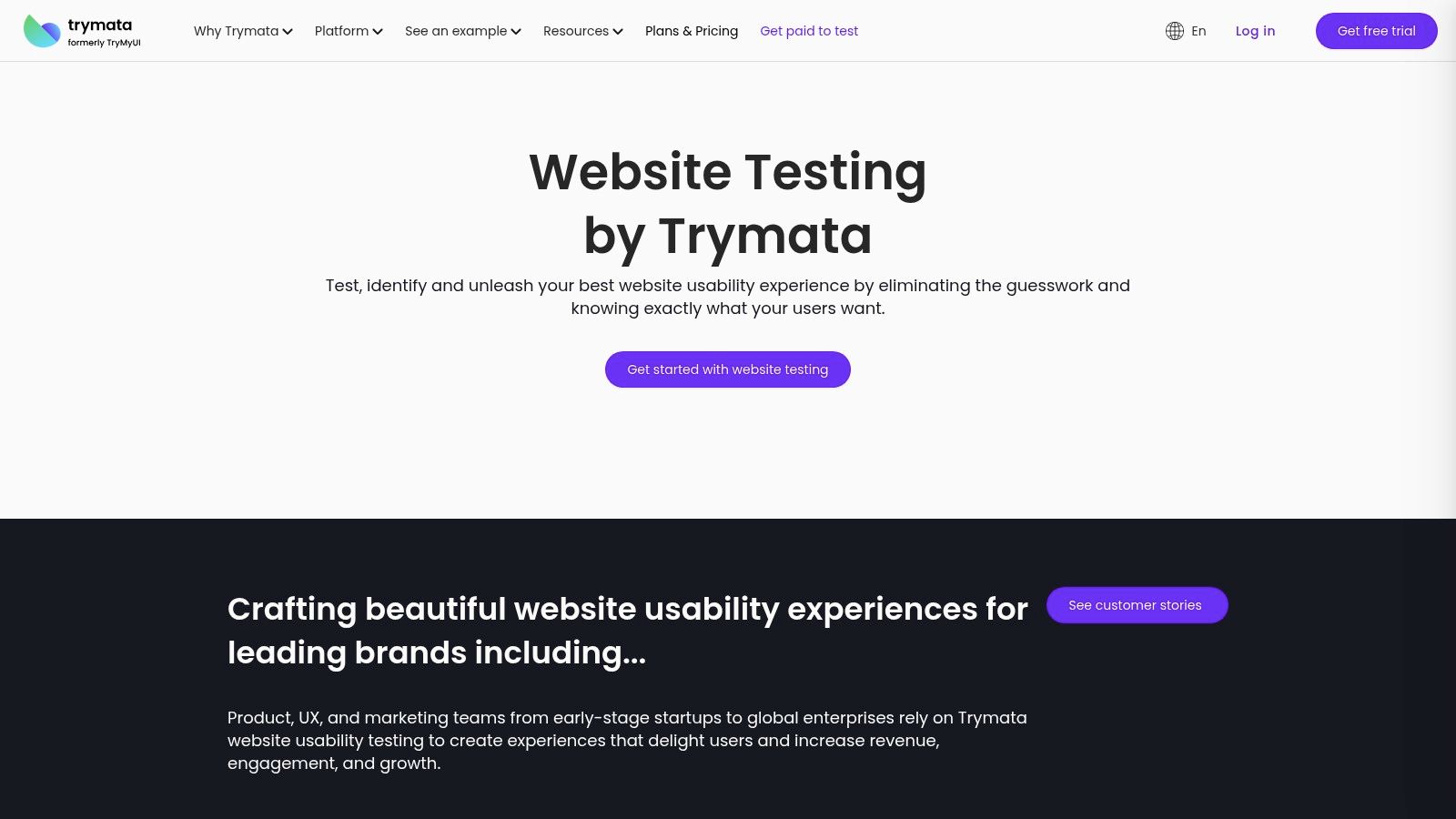
For React Native teams, TryMyUI provides a cost-effective way to validate UI/UX concepts with real people before a wide launch. Testers complete sessions that typically last 20-30 minutes, providing narrated feedback about their experience. This qualitative data helps pinpoint confusing navigation, unclear button labels, or frustrating workflows, making it a valuable tool for iterative design improvements and one of many mobile app testing best practices.
Key Features and Use Cases
- Narrated Video Feedback: Receive screen recordings with concurrent user narration to understand the thoughts and feelings behind user actions.
- Written Survey Responses: Supplement video feedback with post-test written questionnaires to gather more structured, quantitative data on specific usability questions.
- Impression Testing: Get a tester’s first impression of your app within the first 15 seconds, a crucial test for user engagement and retention.
Practical Tip: Use TryMyUI’s impression testing feature early in your design process. Ask testers what they think your app is for and what they would do first. This can quickly reveal if your core value proposition is clear to a new user.
While the platform offers a more accessible price point compared to some enterprise solutions, the pool of available testers can sometimes be limited, which may affect turnaround times. It’s an excellent choice for teams needing quick, qualitative feedback on specific user flows and design elements within their beta testing apps.
Website: https://www.trymyui.com/
10. Userfeel
Userfeel offers a straightforward and effective approach to usability testing, making it a valuable resource for teams looking to gather quick, qualitative feedback. The platform connects developers with a panel of testers who record their screen and voice while completing specific tasks on your website or mobile app. This method provides direct insight into how real users interact with your interface, where they get confused, and what parts of the experience delight them.
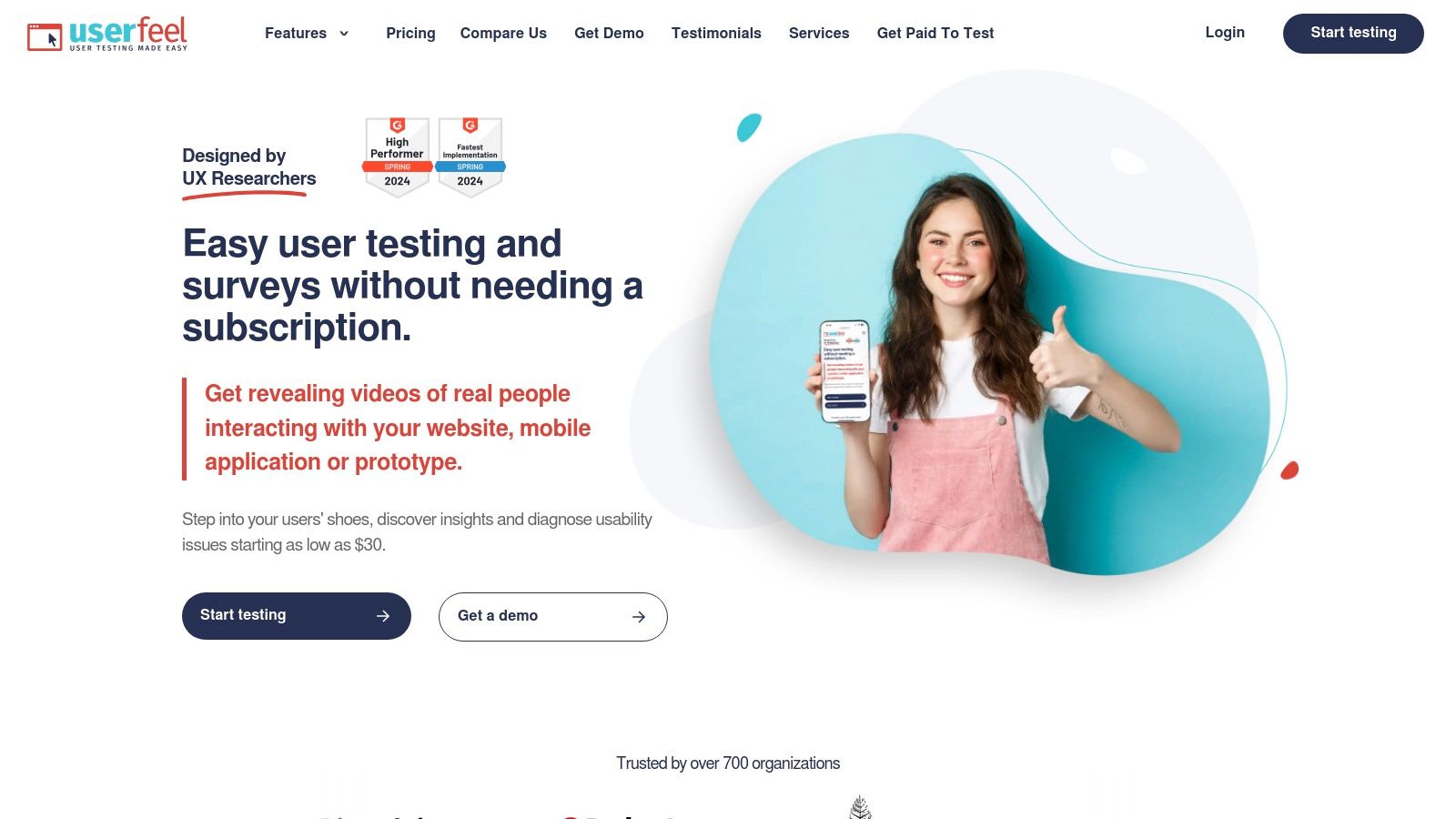
For React Native teams, Userfeel is particularly useful for rapid, scenario-based validation. Instead of just relying on analytics, you can hear a user’s thought process as they navigate a feature for the first time. The tests are designed to be short, typically lasting 10-20 minutes, which encourages focused feedback on specific user flows. This makes it an excellent choice for iterating quickly on UI/UX designs or validating a new feature before a wider release.
Key Features and Use Cases
- Multilingual Testing: Access a global panel of testers who can provide feedback in over 40 languages, crucial for apps with an international audience.
- Screener Questions: Filter testers based on specific criteria by adding screener questions to ensure you get feedback from your exact target demographic.
- Unmoderated & Moderated Tests: Choose between quick, unmoderated tests for fast feedback or live, moderated sessions for deeper, interactive discussions.
Practical Tip: To maximize value, use Userfeel for very targeted micro-tasks. For example, test the onboarding sequence or the process of changing a specific profile setting. The short test duration is perfect for getting high-quality, focused feedback on one part of your app at a time.
While testers must pass a qualification test to ensure quality, the platform’s pay-as-you-go pricing model makes it accessible for teams of all sizes without requiring a long-term subscription. This flexibility is ideal for project-based needs and makes Userfeel a strong contender among beta testing apps for qualitative insights.
Website: https://www.userfeel.com/
11. Userlytics
Userlytics operates in a similar space to UserTesting, offering a flexible platform for moderated and unmoderated usability studies across websites, prototypes, and mobile applications. It provides development teams, including those working with React Native, access to a global panel of testers for gathering qualitative feedback. The platform emphasizes flexibility in test creation and participant recruitment, allowing for a wide range of study types, from simple task-based tests to more complex, branching logic scenarios.
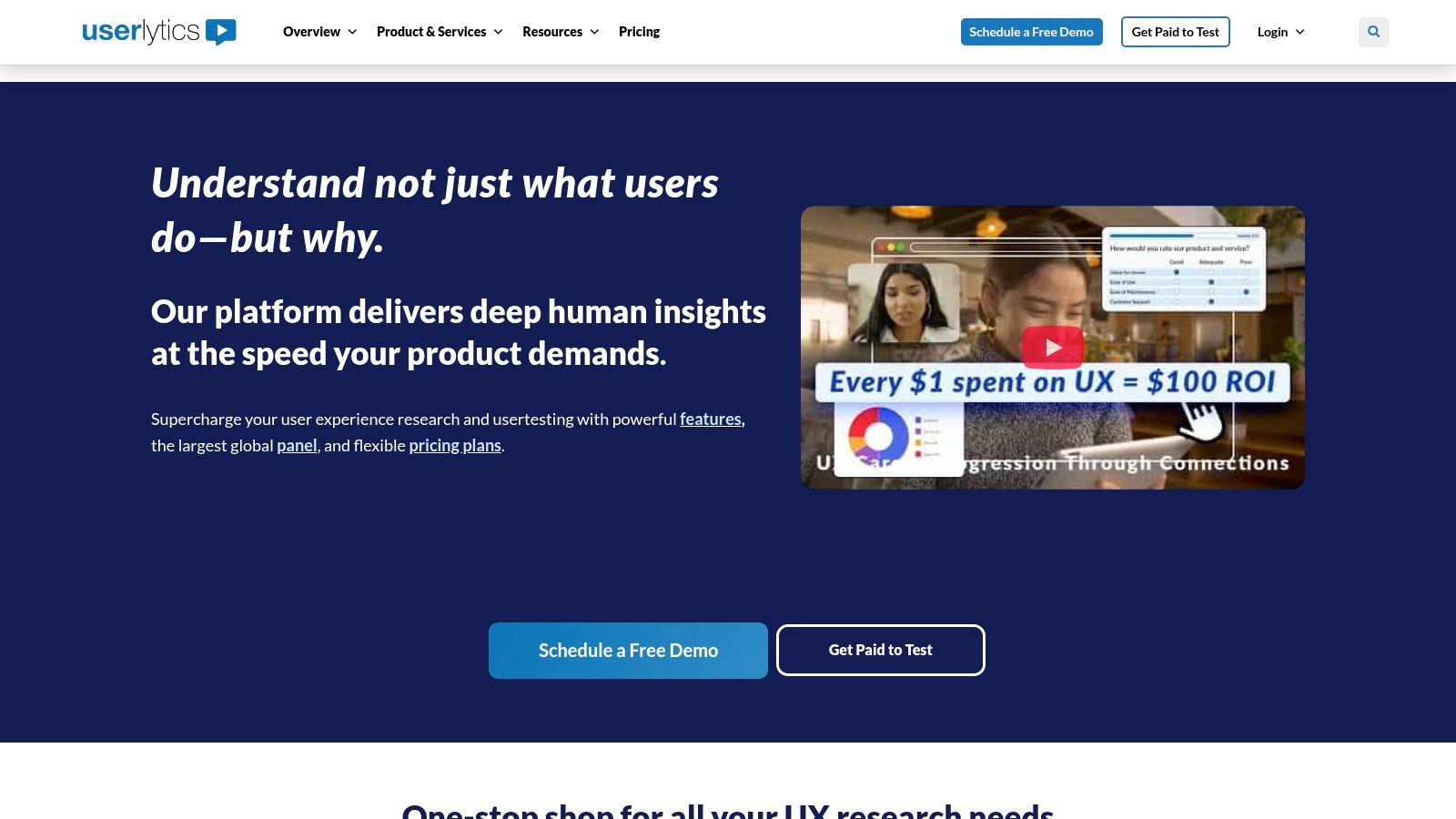
For companies looking to engage in beta testing apps, Userlytics provides the tools to record a user’s screen, voice, and webcam as they interact with the product. This multi-layered feedback helps developers understand not just what users are doing, but also their emotional reactions and thought processes. Its strength lies in offering a variety of pricing models, from pay-as-you-go to enterprise subscriptions, making it accessible to businesses of different sizes.
Key Features and Use Cases
- Advanced Test Logic: Create sophisticated tests with conditional branching, allowing you to direct users down different paths based on their answers or actions.
- Picture-in-Picture Recording: Capture both the user’s screen and their facial expressions simultaneously to analyze emotional responses to your React Native app’s UI.
- Flexible Participant Sourcing: Use the Userlytics global panel, bring your own testers, or recruit participants from a third-party source, all managed within the platform.
Practical Tip: Leverage the platform’s demographic and screener question features heavily. If your React Native app is for a niche audience, precise screening is crucial for getting relevant feedback and avoiding wasted test credits on unqualified participants.
Userlytics is an excellent choice for teams that need a powerful and flexible user research tool without being locked into a high-tier enterprise contract. It effectively bridges the gap between basic feedback collection and full-service research platforms, offering robust features for in-depth usability and experience testing.
Website: https://www.userlytics.com/
12. PingPong
PingPong carves out a niche in the user research space by focusing exclusively on high-quality, moderated remote user interviews. Unlike platforms geared toward automated bug reporting, PingPong connects React Native teams with a pre-vetted panel of articulate testers for live, in-depth conversations. This makes it a premium choice for gathering rich, qualitative insights and understanding the user’s emotional and cognitive responses to your app’s design and functionality.
The platform is built around facilitating one-on-one video calls where developers, designers, or product managers can observe users interacting with their app in real-time. This direct interaction is invaluable for asking follow-up questions and digging deeper into usability issues. PingPong handles all the logistics, including recruiting, scheduling, and paying testers, allowing your team to focus solely on the research itself. Its emphasis on high-quality participants ensures the feedback is clear and actionable.
Key Features and Use Cases
- Moderated User Interviews: Conduct live, guided sessions to observe user behavior and ask clarifying questions on the spot.
- Tester Recruitment & Scheduling: The platform manages the entire process of finding and scheduling qualified testers based on your specific demographic needs.
- Prototype & Website Testing: Get detailed feedback not only on your live React Native app but also on early-stage prototypes or web-based components.
Practical Tip: Prepare a detailed interview script and a list of key tasks before your session, but be ready to deviate. The biggest value of live interviews comes from exploring unexpected user behaviors and comments that arise organically during the test.
PingPong is ideal for teams that prioritize deep, qualitative feedback over large-scale quantitative data. While it’s a pay-per-interview model and more expensive than many automated beta testing apps, the depth of insight from a single session can often be more valuable than hundreds of crash reports, especially when refining complex user flows. For teams focusing on continuous improvement, understanding how to best manage updates after gathering feedback is crucial. You can learn more about managing app updates effectively.
Website: https://www.pingpong.com/
Beta Testing Apps Feature Comparison
| Platform | Core Features/Characteristics | User Experience/Quality ★ | Value Proposition 💰 | Target Audience 👥 | Unique Selling Points ✨ |
|---|---|---|---|---|---|
| 🏆 CodePushGo | Instant OTA React Native updates, E2E encryption, CI/CD integration | ★★★★★ | One-time $2,600 + $300/mo, open source | React Native dev teams | Smart differential updates, real-time analytics, one-click rollback |
| UserTesting | Website/app testing, verbal feedback required | ★★★★ | $10 per 20-min test | Testers who verbalize thoughts | Consistent test stream, easy application |
| Testbirds | Usability, functionality, localization testing | ★★★★ | $20-$50/hr depending on complexity | Flexible global testers | Diverse test types, flexible participation |
| BetaTesting | Tests apps/websites, pays per test | ★★★★ | $10-$20 per test | Testers with access to major brands | Testing for well-known brands |
| uTest | Usability & bug testing, advanced technical projects | ★★★★ | $5-$50+ per test | Global testers, tech-savvy testers | Wide test range, higher earnings opportunity |
| Beta Family | iOS/Android app focus, flexible test selection | ★★★ | $5-$20 per test (min withdrawal $50) | Mobile app testers | Tester choice, global community |
| Betabound | Free to join, software/hardware/app/game testing | ★★★ | Variable, incentives mostly non-monetary | Beta testers seeking incentives | Free participation, diverse opportunities |
| Test IO | Functional, usability, localization testing | ★★★★ | Up to $50 per test | Testers targeting leading companies | Bug severity-based earnings, monthly pay |
| TryMyUI | Usability tests with screen & voice recording | ★★★ | $10 per test | Flex-schedule usability testers | Flexible scheduling, consistent pay |
| Userfeel | Short usability tests, screen & voice recording required | ★★★ | $10 per test | Qualified usability testers | Short test duration, regular payment |
| Userlytics | Usability tests for websites/apps/prototypes | ★★★★ | $5-$90 per test | Diverse usability testers | Wide pay range, demographic targeting |
| PingPong | In-depth user research, video calls | ★★★★ | €40 ($47) per 30-min session | English-fluent, strong communicators | High pay per session, detailed research |
Choosing the Right Beta Testing App for Your React Native Workflow
Navigating the landscape of beta testing apps can feel overwhelming, but making an informed choice is a critical step toward releasing a stable, user-loved React Native application. Throughout this guide, we’ve explored a wide spectrum of platforms, from comprehensive, all-in-one solutions to specialized services that connect you with dedicated communities of testers. The right choice doesn’t hinge on finding a single “best” platform, but rather on identifying the tool that aligns perfectly with your team’s specific workflow, budget, and testing objectives.
Reflecting on the tools we’ve covered, a clear pattern emerges: the world of beta testing is not one-size-fits-all. Your decision-making process should be a strategic exercise, balancing your most pressing needs against the features and limitations of each platform.
Synthesizing Your Options: A Strategic Recap
To distill this complex choice into a manageable decision, consider your primary goals. Are you a small team needing quick, unmoderated feedback on a new feature? A platform like Userfeel or TryMyUI might offer the speed and direct insights you need without the overhead of enterprise-level management.
Conversely, if you’re a larger organization preparing for a high-stakes launch, a more robust solution is essential. Platforms like Testbirds or uTest provide access to a massive, diverse pool of testers, enabling you to validate your app across countless device configurations, demographics, and real-world network conditions. This level of rigor is invaluable for ensuring your React Native app performs reliably for every user segment.
Key Decision Factors for Your React Native Team
Before committing to a platform, lead a discussion with your team centered on these critical factors. Your answers will illuminate the path forward and prevent you from investing in a tool that doesn’t fit your process.
- Integration and Workflow: How well does the platform integrate with your existing CI/CD pipeline and development tools like Jira, Slack, or GitHub? A seamless integration minimizes friction and encourages consistent testing. For React Native developers, the ability to quickly distribute new builds is paramount.
- Tester Sourcing: Do you need to bring your own testers (BYOT), or do you require access to a managed community? Platforms like BetaTesting excel at recruiting specific user personas, while others are built for internal testing with your own curated group.
- Feedback Type: What kind of feedback is most valuable at your current stage? Are you looking for quantitative crash reports and performance metrics, or do you need qualitative, think-aloud video feedback to understand user intent and frustration? Many beta testing apps specialize in one over the other.
- Budget and Scalability: Your budget will naturally narrow the field. Evaluate not just the initial cost but also the pricing model’s scalability. Does the cost grow predictably with your user base or testing frequency? Ensure the plan you choose today will still make sense six months from now.
- Security and Compliance: For enterprise teams or those handling sensitive user data, security is non-negotiable. Scrutinize each platform’s compliance certifications (like SOC 2 or ISO 27001) and data handling policies to ensure they meet your organization’s standards.
Final Thoughts: From Beta Testing to Continuous Improvement
Ultimately, the goal of employing these beta testing apps is to build a resilient feedback loop. Your chosen tool should empower you to not only catch bugs before they reach production but also to gather actionable insights that drive product strategy. This process transforms testing from a pre-launch gate into an integral, continuous part of the development lifecycle.
By carefully evaluating your needs against the diverse options available, you can select a beta testing partner that empowers your React Native team to ship with confidence. The right platform will help you build better software, foster a user-centric culture, and ultimately, deliver an application that delights your audience and achieves its business goals.
Ready to supercharge your release process? While many beta testing apps help you gather feedback, efficiently acting on that feedback is just as crucial. CodePushGo enhances your workflow by allowing you to deploy bug fixes and updates directly to your users’ devices, bypassing the app store review process. Integrate it with your chosen beta platform to create a powerful cycle of testing, fixing, and instantly deploying, ensuring your testers always have the latest, most stable build.

